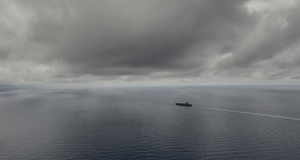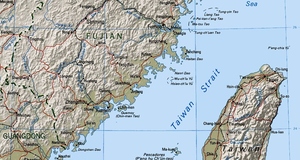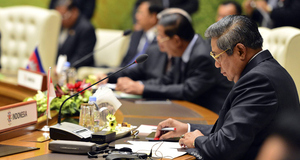Featured Article:Trade and Conflict in South Asia: Examining the Relationship Between Trade Interdependence and Militarized ConflictFindings of the Relationship between Level of Trade and MID Count in South AsiaAfter importing the trade and MID datasets into SPSS, I ran an analysis on the two variables of interest- trade interdependence and number of MIDs- for each South Asian country pair per year. The result of the correlation test for the two variables of interest was a slightly positive correlation that is not statistically significant at the 0.05 level (see Table 1.1). This finding is contrary to what I had expected, which is a negative correlation that is statistically significant. However, the results are still inconclusive for the most part, since the correlation I found was not statistically significant and the linear regression for the best fit line only had an R2 value of 0.003, which is a measure of how well the regression line approximates the real data points (see Table 1.2). Therefore, the regression line that is derived for the overall dataset only approximates 0.3 percent of the cases well. Since no statistically significant correlation was found and the R2 value for the regression line is negligible, these results neither confirm nor refute my hypothesis that increased dyadic trade interdependence leads to decreased numbers of dyadic MID occurrence between two nations in South Asia. Table 1.1: South Asia Trade Interdependence and MID Dataset Correlations
Table 1.2: South Asia Trade Interdependence and MID Dataset Bivariate Linear Regression
Since my analysis of the overall dataset delivered inconclusive results, I decided to remove country pairs that did not exhibit any signs of conflict in the years recorded. The reason for this omission is because a relationship between the two variables of interest cannot be established if no instances of MIDs were reported throughout the history of two countries’ trade relations. Then, I ran a bivariate linear regression again for the dataset with omissions and the results showed a slightly negative correlation that was not statistically significant at the 0.05 level. Next, I decided to focus on the dyads that had at least five MID occurrences in the time range specified, since any fewer MIDs would not help me find conclusive evidence of a relationship between trade interdependence and occurrence of MIDs that could be generalized for the South Asian region as a whole. Thus, I broke down my data into separate datasets for each dyad that showed at least five occurrences of MIDs in the years of interest and then I re-analyzed the datasets for possible correlations between the two primary variables- trade interdependence and number of MIDs. After excluding the other country pairs, the dyads I focused on are the following: Afghanistan and Pakistan, China and India, India and Bangladesh, India and Pakistan, and India and Sri Lanka. Of the pairs listed, only one resulted in a correlation that was statistically significant at the 0.05 level- China and India- and it was a moderately negative correlation, which is consistent with my expectation of a negative relationship between the two variables of interest (see Table 1.3). Moreover, the regression for the China-India data subset has an R2 value of 0.089, which means the line can approximate 8.9 percent of cases well. Accordingly, compared to the overall dataset, the China-India subset displays a significantly stronger correlation between the variables of trade interdependence and MID occurrence (see Graph 2.1). Meanwhile, of the remaining pairs, the only dyadic pair that had a correlation that was significant at less than the 0.07 level also had a negative correlation. That pair was India and Sri Lanka, which had a moderately negative correlation that was statistically significant at the 0.065 level. The linear regression test for India-Sri Lanka resulted in a best fit line that approximates well for 6.6 percent of cases. Table 1.3: China-India Trade Interdependence and MID Dataset Correlations
The rest of the dyads had correlations that were not statistically significant at less than the 0.65 level and the regression best-fit lines approximated well for 0.5 percent of the cases or fewer. Thus, the R2 values for the remaining dyads of Afghanistan-Pakistan, India-Bangladesh, and India-Pakistan are not high enough for the linear regressions to approximate occurrences of MIDs in the remaining dyads. As a result, I decided to look at each of the five dyads as miniature case studies and use further quantitative research in order to understand whether the direction of the relationship I had predicted may have been reversed and which perspectives of International Relations theory, liberalism and/or realism, are evident in the trade-conflict model in South Asia. Afghanistan-Pakistan Upon closer inspection of the trade interdependence and MID dataset for Afghanistan and Pakistan, I noticed that drastic drops in trade interdependence most often occurred following an MID the previous year. This observation prompted me to re-analyze this specific data subset using trade interdependence as the dependent variable, rather than the independent one, and MID occurrence from the previous year as the independent variable. In order to accomplish this reversal in variables, I used STATA time-lag regression, which allowed me to use the MID count from the previous year to correspond with the trade interdependence number for the following year. My results, as shown in Table 1.4, demonstrate that for this particular dyad, the causal relationship between MID occurrence and trade interdependence is statistically significant at the 0.06 level and it is in the opposite direction from what I had expected. Essentially, according to the time-lapse linear regression from STATA, MID occurrence in the previous year leads to a drop in trade interdependence the following year. However, the first time-lag linear regression, which covered all the years from 1956 to 2001, only had an R2 value of 0.056, which means it only approximates 5.6 percent of the data points well. Table 1.4: Afghanistan-Pakistan MID v. Trade Interdependence Time-Lag Linear Regression 1
Next, I decided to break down the Afghanistan-Pakistan dataset into smaller subsets and one of the time-lag regressions I ran was for the years of 1958 to 1965. This particular linear regression resulted in a statistically significant slightly negative correlation between the two variables- MID count from the previous year and trade interdependence in the following year- and it had an R2 value of 0.5727, which means it approximates over 57 percent of the data points well (see Table 1.5). This R2 value shows that the regression for this subset is a much better predictor of the seven year span it covers than the regression that covers over 50 years of data. Table 1.5: Afghanistan-Pakistan MID v. Trade Interdependence Time-Lag Linear Regression 2
Moreover, I noticed an interesting trend in the Afghanistan-Pakistan dataset following the year 1988. I saw a significant drop in the trade between Afghanistan and Pakistan beginning in 1989, even though an MID had not occurred the previous year. I found this deviation from the trend intriguing so I decided to investigate this observation further by using some scholarly sources. Through my research, I discovered that Afghanistan plunged into civil war in 1989 following the withdrawal of Soviet troops from the region that year (Blood 2001). This finding leads to my conclusion that sometimes outside variables, such as the domestic political conditions in a nation, do affect the level of trade it engages in with other countries. Therefore, even though a relationship can be established between trade interdependence and MID count, there are other variables that can affect one or both of these variables of interest. China-India The initial bivariate linear regression I ran with trade interdependence as the independent variable and MID count as the dependent variable resulted in a statistically significant, moderately negative correlation at the 0.05 level between the two variables of interest. When I ran the time-lag linear regression with MID count from the previous year as the independent variable for the years from 1950-2001, however, the results also came out with a statistically significant, slightly negative correlation between the two variables of interest (see Table 1.6). While these results may seem contradictory, since the independent and dependent variables are switched, it is not necessarily the case. First of all, the first bivariate linear regression has an R2 value of 0.89, which means it only approximates well for 8.9 percent of real data points and the time-lag linear regression has an R2 value of 0.0581, which means it approximates well for another 5.81 percent of real data points. Therefore, realistically, it is possible for one of the linear regressions to predict well for certain years of the China-India dataset, and the other one to predict well for another time range in the same dataset. Furthermore, the relationship between trade interdependence and MID occurrence could be a self-fulfilling cycle in which a drop in trade interdependence leads to more MIDs, which then leads to a drop in trade levels, and so on. Table 1.6: China-India MID v. Trade Interdependence Time-Lag Linear Regression
Two interesting trends I found in the China-India dataset occurred in the years from 1954-1956 and 1988-1989. In the first time range, I noticed that even though India and China experienced an MID in all three years- 1954, 1955, and 1956- the level of trade interdependence between the two countries continued to rise. When I looked into these years, I learned that India and China had signed an agreement known as the “Five Principles” of peaceful coexistence in 1954 that aimed to promote the concepts of “Indians and Chinese are brothers” and “eternal peace and friendship” (Singh 1998). Therefore, even though they engaged in minor skirmishes along their shared borders, India and China attempted to promote a peaceful relationship that was most likely enhanced by increased trade interdependence between the two countries. This idea explains why even though the two nations had MID occurrences in the years between 1954 and 1956, they must have tried to keep relations cordial and increase trade levels to show their commitment to building a peaceful coexistence. Meanwhile, the trend seen between the years of 1988 and 1989 is quite opposite in relation to the one exhibited between 1954 and 1956: even though there was no report of an MID occurrence in 1988, the trade interdependence between India and China still dropped considerably in 1989. When I investigated this slight blip, I found that Rajiv Gandhi, the prime minister of India at the time, had visited China in December of 1988 in an effort to alleviate growing tensions between the two nations. However, most scholars agree that the trip resulted in meager outcomes that did not accomplish much. Moreover, Gandhi was severely criticized by the Indian media for conceding that Tibet was an internal Chinese affair, which implies that many people within India were not content with the way China was dealing with Tibet (Ganguly 1989). This internal discontent with China might have contributed to the decrease in trade between India and China that is seen in the dataset.Continued on Next Page » Suggested Reading from Inquiries Journal
Inquiries Journal provides undergraduate and graduate students around the world a platform for the wide dissemination of academic work over a range of core disciplines. Representing the work of students from hundreds of institutions around the globe, Inquiries Journal's large database of academic articles is completely free. Learn more | Blog | Submit Latest in International Affairs | |||||||||||||||||||||||||||||||||||||||||||||||||||||||||||||||||||||||||||||||||||||||||||





















